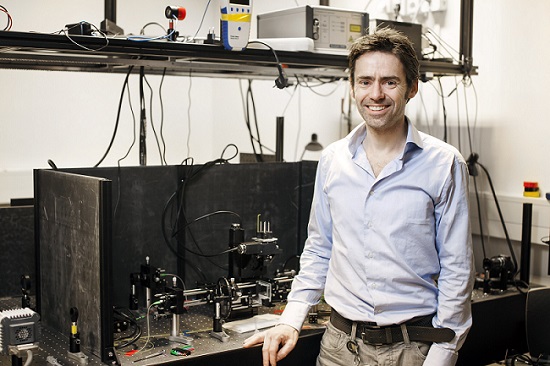DELFT, Netherlands, Dec. 3, 2020 — A method based on optical coherence tomography (OCT) could improve the abilities of scientists and medical personnel to evaluate biopsies. The technique, developed by researchers at TU Delft, images four times deeper than traditional OCT approaches.
As opposed to a traditional OCT scan, the researchers using the method do not make images with reflected light, instead sending the light directly through tissue. A sensor on the other side captures the light, measuring the specific wavelengths that arrive — and when.

Researcher Jeroen Kalkman stands next to his new imaging setup. Courtesy of TU Delft.
“The light that travels for a longer period of time is scattered though the tissue and arrives at the detector relatively later,” TU Delft researcher Jeroen Kalkman said. “Usually, this causes the resulting images to be blurred. But by looking at the arrival time we can separate this scattered light from the light that went straight through the sample. With the light that arrives early, we can produce a sharp image.”
To create a cross section, or tomogram, of an object, the researchers used technologies associated with computer tomography.
“This involves measuring a projection of the x-rays coming through the object at many different angles and positions,” Kalkman said. “You can then connect all these different projections together using a computer to create a three-dimensional image. We do the same thing, but with light.”
The researchers tested their method on dead zebra fish and determined the maximum depth of penetration to be approximately 4 mm, representing an improvement factor of four compared to the present reflection approach of OCT. Additionally, the zebra fish organs could be depicted with high contrast by looking at both the strength and the arrival time of the light.
“We have been working on this with a whole team of researchers for almost 10 years, so it’s a huge thrill that we’ve finally got it done,” Kalkman said.
The researchers predict that the technique will generate valuable information about certain diseases.
“With our method, we would be able to follow the development of such a disease very precisely over time,” Kalkman said. “That way, we could study the effects of medicines or, conversely, potentially toxic substances on tissue. Doing so could provide us with useful insights that can ultimately lead to better treatments or better protection.”
Another potential application is the analysis of biopsies.
“Currently, labs often add fluorescent labels to biopsies or they cut them into small slices and use optical clearing to make them more transparent,” Kalkman said. “This takes a long time, and during this process biopsies can deform. We expect our technique to be able to image the biopsies in their three-dimensional form, thus helping doctors make a more accurate diagnosis.”
The research was published in Optica (www.doi.org/10.6084/m9.figshare.c.4989020.v2).